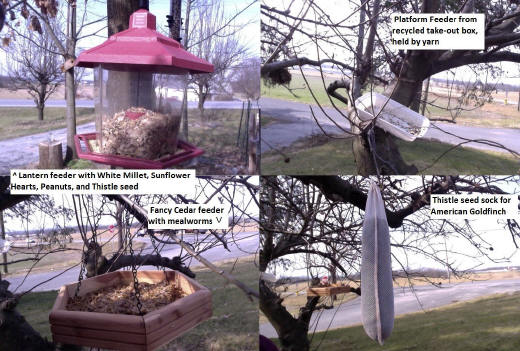(2/23) This past year I decided to attract birds to my yard using bird feeders. I tried different feeder styles, food, and locations. Some worked well and some, well, didnít work. Here are some of the lessons that I learned:

1. Bird seed goes bad. I inherited a large bag of bird seed from my father who was trying to clear out his garage. I thought, "Great! A free bag of bird seed for my feeder project." I filled my new "lantern" style feeder with the seed and waited. A day. A week. No birds came. When I told my dad that the birds donít like his seed, he responded, "Well Iím not surprised.
That bird seed is probably 10 years old!" Apparently, bird seed will only stay fresh for about 4 months.
2. Birds identify food by sight. Well, I replaced the old seeds with new fresh ones. Another few days went by without much luck until I followed a friendís recommendation. I spread seeds on the ground around the bird feeder. I lathered peanut butter on some of the limbs and sprinkled seeds into the sticky spread. I even laid a trail of seeds leading from the forest
edge to my bird feeder. Maybe that last idea was overkill, but it worked! Chickadees and titmice started visiting my lantern feeder!
3. Feeders donít have to be fancy or expensive. Inspired by my success, I decided to diversify. Being financially-challenged, I created my own feeder using a recycled food take-out box. I punched some holes in the bottom to let out water and tied the box to a Y in the tree using cotton yarn. It was not the most elegant-looking platform feeder, but the birds didnít
mind. Chickadees, titmice, and even a downy woodpecker were (and still are!) frequent visitors.
4. Thistle (nyjeer) seed is not very popular. The seed mix that I bought included sunflower hearts, white millet, peanuts, and thistle seed. My do-it-yourself platform feeder was extremely popular, but no one seemed to like the thistle seed. These tiny black seeds would end up in a watery pile in a corner of my feeder, rejected. A couple times I just scooped the seeds
out and sprinkled them on the ground, but one day I noticed a new bird pecking at those thistle seeds. The American goldfinch!
5. White millet is for the ground feeders. Another apparent reject seed was white millet. Many birds on the feeder kicked out the white millet while searching for the most popular seed Ė black oil sunflower. I saw the white seeds all over the ground under my feeder and worried that they would sprout or go to waste. But soon they were gobbled up by mourning doves and
small flocks of juncos.
6. Birds have predators Ė keep them safe. My very first "lantern" style feeder I hung in a tree just outside my kitchen window. It was the perfect spot where I could sit, eat breakfast, and spy on the birds. I spotted a chickadee and was fumbling with my binoculars when I heard, "Bark!" The chickadee and all of the other birds resting in the tree flew away. My dog
reminded me to be more mindful about other predators that the songbirds face Ė hawks! I moved the feeder to an apple tree in my front yard which is near a row of evergreen trees. The birds have cover and I can still enjoy watching them.
7. Feeders need to be maintained. After a rainstorm, I checked on my bird feeders and found many of the exposed seeds to be sopping wet. I scraped away some of the seeds and found mold growing underneath. I donít want to eat mold, and neither do birds. I cleaned the feeder and refilled it, but only half way. The birds are slow to empty my feeders, so filling the feeder
only part way helps to make sure that the seeds are fresh.
I hope these lessons are helpful as you design your bird feeding station. My learning is far from over. I have yet to encounter the squirrel problem! For now, I will be content to know that I am doing a small part to help the birds as they begin their spring migration. With increased habitat loss, they need all the help they can get!